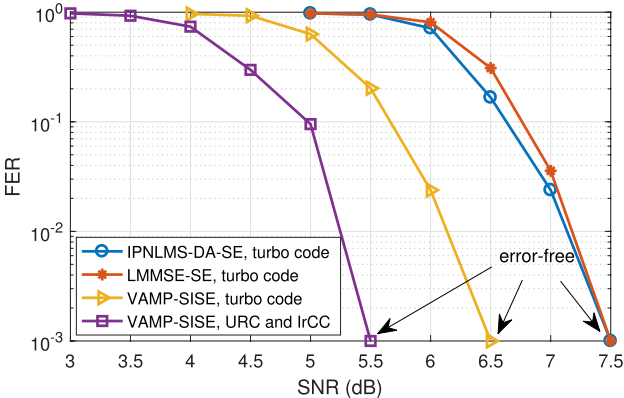Deep-sea vertical underwater acoustic (UWA) communication plays an important role in oceanic observations and exploitations, such as 10000-m real-time communications between the manned submersible Fendouzhe and its mother ship Explorer-I, the instant messaging between underwater unmanned vehicles and the surface end, and the data return of seafloor sensors. However, it generally faces several challenges including fast-varying Doppler, loud impulsive noise, and limited transmitting power. At present, the receiver structure of the existing deep-sea vertical UWA communication systems concatenates an adaptive equalizer and a phase-locked loop. This receiver structure has low complexity and decent channel-tracking ability, but it suffers from the error propagation and needs a high signal-to-noise ratio (SNR) level.
Researchers from the Institute of Acoustics of the Chinese Academy of Sciences (IACAS) have been engaged in the research of underwater acoustic communication for a long time. They have developed the UWA communication systems for a series of manned submersibles including the 7000-m Jiaolong, 4500-m Shenhai Yongshi, and the full-depth Fendouzhe. Recently, doctoral student LI Dong and Professor WU Yanbo of the team proposed a novel iterative receiver for deep-sea vertical UWA communications, breaking through existing receiver structures of deep-sea UWA communication in the aspects of channel Doppler compensation, channel equalization and error correcting code design.
Aiming at the non-constant Doppler variation induced by the rapid source-receiver motion as well as wave undulations, researchers achieved the Doppler compensation in the whole data frame by nonuniform resampling based on the proposed spline interpolation-aided successive timing estimation. The data processing results of the 5000-m sea trials of Jiaolong showed the proposed Doppler compensation method significantly outperformed the traditional method. After the Doppler compensation, the channel was approximately time-invariant, which meant the receiver no longer needed the phase-locked loop.

Figure 1. Variations of the channel impulse response’s real part (upper) and imaginary part (lower) after the traditional Doppler compensation (left) and the proposed Doppler compensation (right). (Image by IACAS)
As to the channel multipath interference and residual timing errors, researchers proposed a fractionally-spaced self-iterative soft equalizer (SISE) based on the vector approximate message passing (VAMP). The VAMP-SISE consisted of four parts: an inner soft slicer and an inner soft equalizer for symbol detection, as well as a denoiser and a minimum mean-squared error (MMSE) estimator for impulsive noise suppression. Different parts iteratively exchanged extrinsic information to capture the self-iterative gain. The experimental results showed the VAMP-SISE was superior to the existing linear MMSE equalizer and the adaptive equalizer was able to suppress the impulsive noise.

Figure 2. Evolution of equalizer output constellation versus self-iterations. (Image by IACAS)
Researchers introduced a unity-rate code (URC) for eliminating the decoding error floor and designed a UWA channel-fitting irregular convolutional code (IrCC), largely lowering the required SNR of the turbo-iteration between the equalizer and the decoder.

Figure 3. Demonstrate of the iteration between the IrCC decoder and the VAMP-SISE. (Image by IACAS)
Sea-trail data verified that compared to the existing deep-sea UWA communication schemes, the proposed iterative receiver had an improvement of two orders of magnitude in terms of frame error rate performance and a signal-to-noise rate (SNR) improvement of 1.5~2 dB, which means the communication distance could be increased by about 25%.

Figure 4. Frame error rate performance comparison under different SNR conditions (single channel processing with impulsive noise background). (Image by IACAS)
The research, published in The Journal of the Acoustical Society of America, was supported by the National Natural Science Foundation of China (Nos. 61971472, 61471351), the National Key Research and Development Program of China (No. 2016YFC0300300), and the Strategic Priority Research Program of the Chinese Academy of Sciences (XDA22030101).
Reference:
LI Dong, WU Yanbo, ZHU Min, TAO Jun. An enhanced iterative receiver based on vector approximate message passing for deep-sea vertical underwater acoustic communications. The Journal of the Acoustical Society of America. 2021. DOI: 10.1121/10.0003625.
Contact:
ZHOU Wenjia
Institute of Acoustics, Chinese Academy of Sciences, 100190 Beijing, China
E-mail: media@mail.ioa.ac.cn


